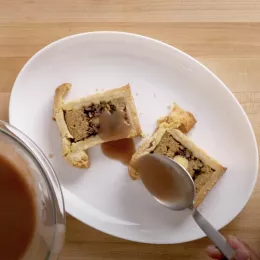I always say, “If you want to truly know a culture… eat their bread.” In France, it could be the baguette; in Ethiopia, you’ll have injera; if you travel to parts of India, you’ll enjoy chapati; Italy will provide focaccia; in West Africa, you can sample a lovely flatbread called ngome. Here in America, there is cornbread.
Some would almost immediately think that this bread has no place on a world stage with other “celebrated” breads. Cornbread tells the story of lack and can get caught up in the stigma of shame and class. For whatever reason, some might refuse to let their brains show love to this bread without realizing that cornbread and its variations were here in the Americas with the Indians, prepared by white folks living in the Appalachian Mountains and put together by black folks before, during and after slavery. Knowing how we think about cornbread shows a path of overlooking or turning a blind eye to how racism exists even in the foods that we perceive to have “importance” on the global scale.
Another angle of looking at it is that cornbread is the product of making something beautiful out of humble ingredients. In ancient times, having corn was like having gold. Native Americans used corn to prepare other dishes, everything from grits to alcoholic beverages. African Americans would make unleavened pone, corn fritters or even hoecakes. For some, even the mention of cornbread creates spontaneous exclamations and smiles of recognition followed by stories usually involving a family member.
Most American families, regardless of background, have a recipe for cornbread. It’s normally one that’s been passed down from aunts and grandmothers, scribbled on the back of a postcard or an old tattered napkin. To me, those are the love letters of generations past that tell a defined story of who we are and speak to our culture in little ways. For example, if you’re from the north, then your cornbread recipe probably has sugar or honey in it. If you’re from the south there is most likely no sweetener. If you are from the Appalachians, then you might tend to prepare your cornbread in a very old-fashioned manner with no leaveners, using simply ground corn, hot water and lard. The luxury of having butter, buttermilk, sugar, honey, baking powder or baking soda usually indicated that you had money. Decoding a simple family cornbread recipe can tell the underlying story of where you come from.
You can see what I mean when I say, “If you want to know about a group of people or their culture: Eat their bread.” No American food has more historical and cultural connections than corn, from Native Americans to the Pilgrims to us today. No single food native to America has become more essential to the survival of so many different nationalities around the globe.
My aunt Sarah Mae was the baker in the family. Her cakes and pies were to-die-for. In the summertime after dinner, she’d prepare some of the absolute best milkshakes made with ice cream, one egg, one banana, milk and a little vanilla extract. She had four children and was a housewife, so she was always in the kitchen preparing something. Many of the deepest kitchen conversations I’ve held onto come from my experiences with her. She was a walking, talking instructional YouTube video when it came to baking technique, never giving you exact measurements, but instead, giving you the play by play of how an ingredient needed to be dealt with in order to gain the best result.
One Sunday after hours of baking cornbread, I was assisting her in wrapping up loaves of cornbread for a church function (in aluminum foil, of course), and my job was to wrap each loaf and write the names of the recipients. For one of the loaves, I asked her, “Aunt Sarah Mae, whose cornbread is this?” She replied by saying, “This cornbread is ours, sweetheart.” And that’s how I feel about us as a culture of human beings when it comes to this delicious American staple.
Whether it’s made in a cast-iron skillet or the end of a hoe, mashed into a paste and fried in lard or all gussied up with leaveners and sweeteners, this cornbread is ours.
Bake your own bread in a professional development class at ICE.




